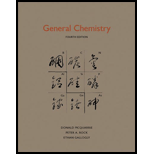
(a)
Interpretation:
Three ions that are isoelectronic with
Concept Introduction:
Neutral atom contains equal number of protons and electrons. When an electron is added or removed from a neutral atom, charged species known as ion is formed. If electrons are removed, then the formed ion is known as cation and if electrons are added, the formed ion is known as anion. Atom that has lost electrons will have positive charge and atoms that have gained electrons will have negative charge.
Isoelectronic species are the ones that contain same number of electrons but different number of protons. They have different chemical and physical properties.
(a)
Explanation of Solution
Given ion is
Therefore, the number of electrons present in
Isoelectronic ions that have
Chlorine has an atomic number of
Calcium has an atomic number of
Scandium has an atomic number of
Therefore, the ions that are isoelectronic with
(b)
Interpretation:
Three ions that are isoelectronic with
Concept Introduction:
Refer part (a).
(b)
Explanation of Solution
Given species is
Isoelectronic ions that have
Bromine has an atomic number of
Rubidium has an atomic number of
Strontium has an atomic number of
Therefore, the ions that are isoelectronic with
(c)
Interpretation:
Three ions that are isoelectronic with
Concept Introduction:
Refer part (a).
(c)
Explanation of Solution
Given ion is
Therefore, the number of electrons present in
Isoelectronic ions that have
Fluorine has an atomic number of
Sodium has an atomic number of
Magnesium has an atomic number of
Therefore, the ions that are isoelectronic with
(d)
Interpretation:
Three ions that are isoelectronic with
Concept Introduction:
Refer part (a).
(d)
Explanation of Solution
Given ion is
Therefore, the number of electrons present in
Isoelectronic ions that have
Tellurium has an atomic number of
Cesium has an atomic number of
Barium has an atomic number of
Therefore, the ions that are isoelectronic with
Want to see more full solutions like this?
Chapter 2 Solutions
General Chemistry
 ChemistryChemistryISBN:9781305957404Author:Steven S. Zumdahl, Susan A. Zumdahl, Donald J. DeCostePublisher:Cengage Learning
ChemistryChemistryISBN:9781305957404Author:Steven S. Zumdahl, Susan A. Zumdahl, Donald J. DeCostePublisher:Cengage Learning ChemistryChemistryISBN:9781259911156Author:Raymond Chang Dr., Jason Overby ProfessorPublisher:McGraw-Hill Education
ChemistryChemistryISBN:9781259911156Author:Raymond Chang Dr., Jason Overby ProfessorPublisher:McGraw-Hill Education Principles of Instrumental AnalysisChemistryISBN:9781305577213Author:Douglas A. Skoog, F. James Holler, Stanley R. CrouchPublisher:Cengage Learning
Principles of Instrumental AnalysisChemistryISBN:9781305577213Author:Douglas A. Skoog, F. James Holler, Stanley R. CrouchPublisher:Cengage Learning Organic ChemistryChemistryISBN:9780078021558Author:Janice Gorzynski Smith Dr.Publisher:McGraw-Hill Education
Organic ChemistryChemistryISBN:9780078021558Author:Janice Gorzynski Smith Dr.Publisher:McGraw-Hill Education Chemistry: Principles and ReactionsChemistryISBN:9781305079373Author:William L. Masterton, Cecile N. HurleyPublisher:Cengage Learning
Chemistry: Principles and ReactionsChemistryISBN:9781305079373Author:William L. Masterton, Cecile N. HurleyPublisher:Cengage Learning Elementary Principles of Chemical Processes, Bind...ChemistryISBN:9781118431221Author:Richard M. Felder, Ronald W. Rousseau, Lisa G. BullardPublisher:WILEY
Elementary Principles of Chemical Processes, Bind...ChemistryISBN:9781118431221Author:Richard M. Felder, Ronald W. Rousseau, Lisa G. BullardPublisher:WILEY





